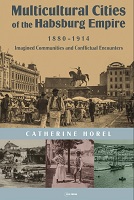Multicultural Cities of the Habsburg Empire, 1880–1914
Imagined Communities and Conflictual Encounters
| dc.contributor.author | Catherine, Horel | |
| dc.date.accessioned | 2023-11-13T12:32:56Z | |
| dc.date.available | 2023-11-13T12:32:56Z | |
| dc.date.issued | 2023 | |
| dc.identifier | OCN: 1381107674 | |
| dc.identifier.uri | https://library.oapen.org/handle/20.500.12657/85028 | |
| dc.description.abstract | Catherine Horel has undertaken a comparative analysis of the societal, ethnic, and cultural diversity in the last decades of the Habsburg Monarchy as represented in twelve cities: Arad, Bratislava, Brno, Chernivtsi, Lviv, Oradea, Rijeka, Sarajevo, Subotica, Timișoara, Trieste, and Zagreb. By purposely selecting these cities, the author aims to counter the disproportionate attention that the largest cities in the empire receive. With a focus on the aspects of everyday life faced by the city inhabitants (associations, schools, economy, and municipal politics) the book avoids any idealization of the monarchy as a paradise of peaceful multiculturalism, and also avoids exaggerating conflicts. The author claims that the world of the Habsburg cities was a dynamic space where many models coexisted and created vitality, emulation, and conflict. Modernization brought about the dissolution of old structures, but also mobility, the progress of education, the explosion of associative life, and constantly growing cultural offerings. | en_US |
| dc.language | English | en_US |
| dc.subject.other | Austro-Hungarian Monarchy; Customs and traditions; Cultural studies; Multiculturalism; Urban studies | en_US |
| dc.title | Multicultural Cities of the Habsburg Empire, 1880–1914 | en_US |
| dc.title.alternative | Imagined Communities and Conflictual Encounters | en_US |
| dc.type | book | |
| oapen.relation.isPublishedBy | 5427f84f-0815-48ff-aac8-56f6200fccab | en_US |
| oapen.relation.isFundedBy | 32b67c16-7387-40c4-b2d0-66bb8374accc | en_US |
| oapen.relation.isbn | 9789633862896 | en_US |
| oapen.pages | 570 | en_US |

